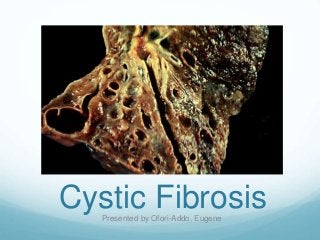
Cystic Fibrosis- PFC Ofori Addo
- 1. Cystic FibrosisPresented by Ofori-Addo, Eugene
- 2. The Disease – Cystic Fibrosis Cystic fibrosis is known to be an inherited autosomal (pattern of inherited genetic disease) chronic disorder mostly seen in children that affects the lungs and the digestive system. It is also known to be most common cause of chronic lung disease mostly seen in children and younger adults. Also known to be the most fatal hereditary disorder that affects numerous Caucasians in the United States (Medline Plus, 2013, Cystic Fibrosis Foundation)
- 3. Statistics As the most common Chronic lung disease in children and some adults, this disorder affects about- 30, 000 children and young adults Where about 1200 children are diagnosed every year About 70% of these patients are diagnosed with the disease at age 2 And about bout 40% of the population being 18 years of age and older. Life span of patients with Cystic Fibrosis is about 37 years (Cystic Fibrosis Foundation, 2014) * Respiratory failure is mostly the major consequence of Cystic Fibrosis and usually what causes death amongst CF Patients Population Children age 2- 70% Young Adults - 40%
- 4. Causes of Cystic Fibrosis This is an inherited diseases complication so its is genetically transmitted From parents through Genes 2 copies of genes are needed to signify inheritance of the disease
- 5. Pathophysiology Cystic Fibrosis becomes present when there is a Defective gene i.e. related to protein that is involved in chloride ion transport Patients with the diseases usually develop unusual thick sticky mucus plugging that clogs the lungs and causes obstruction which leads to life- threatening lung infections and also obstruction in the pancreas. Cystic Fibrosis Explained https://www.youtube.com/watch?v=LItSsV JPQEY
- 6. Symptoms Cystic fibrosis have several symptoms which include - A persistent cough that produces thick spit (sputum) and mucus Wheezing Shortness of breath Meconium ileus which appears at birth Salty-tasting skin which is usually greasy feeling, bulky and has a bad smell Frequent lung infections
- 7. Diagnostic Testing Genetic Study (analysis) When a new born child has signs and symptoms confirmed, diagnosis of CF can usually be done by using Blood Test Since it is an inherited diseases, family members should be checked for possible diagnosis The Sweat test This test is a very accurate way of diagnosing CF. Test measures Sodium and or chloride amounts present in patient’s sweat. (test not reliable in newborns)
- 8. Other common diagnosis When a patient presents Cystic Fibrosis, they are usually seen to have these further complications- Inability for effective airway clearance Inability to digest food and absorb nutrients which causes imbalanced nutrition
- 9. Cystic Fibrosis – X-RAY Young man with a history of cystic fibrosis has hyperinflation and predominantly upper lobe bronchiectasis. Bronchiectasis is a condition in which damage to the airways causes them to widen and become flabby and scarred. A chest x ray can show areas of abnormal lung and thickened, irregular airway walls.
- 10. Therapy and Management Planning and intervention usually include- Provision of respiratory therapy treatments Chest physiotherapy to clear secretions Administering medications Meeting nutritional needs Providing fat soluble vitamins like A, D, E, K to prevent deficiency Providing psychosocial support
- 11. Treatments These help and aim at relieving symptoms and complications of CF Aerosolized antibiotics Mucus-thinning drugs that thin out secretions and makes it easier to cough up Use of bronchodilators As the purpose of relaxing smooth muscles in the airways Bronchial airway drainage Postural drainage
- 13. Drugs Contd..
- 14. Treatment contd.. Enzymes taken orally for better nutrition Should contain high calorie diet since CF patients are usually malnutritioned due to pancreatic enzymes needed to digest are not available Lung transplant at its worst Significant when there is severe breathing problems that has lead to life-threatening infections of the lungs Pain relievers such as Ibuprofen- may help slow down lung deterioration
- 15. Questions? What do you call a nun with a lung infection and general mucus build-up? Sister Fibrosis. www.cysticfibrosisfoundation.com